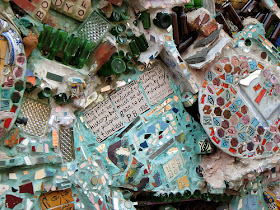One of the most unique streets in America is South Street in Philadelphia. The sidewalks are the showcase for an array of characters and an assortment of unusual shops. With all the existing subcultures represented in the area, it's only fitting that in the hub of all this lies an artistic playground.
The Magic Gardens catches your attention from blocks away. The glimmering glass flickering in the sun attracts your eye to this unique adobe, hidden on a road of sideshows. The building is a collage of art pieced together with glass, bottles, marbles, broken plates, and about anything else the artist could get his hands on. But the true masterpiece lies within.
Opening these doors and passing through is almost the equivalent of following the rabbit down the hole. Except this is a different type of Wonderland. The interior walls are plastered in mosaics. Bright colors swirl around hidden images. Feelings of vertigo pass through as I extend my neck to look above me and follow the menagerie of colors that are blossoming around me. The colors may begin to blend into psychedelic imagery. There's another door inviting you back outside, but it's not the outside you were accustomed to. You pass through the looking glass, and proceed out.
Now you find yourself in a maze of mosaics. Bicycles extend out of walls. Porcelain dolls protrude through cement. Kitchen tiles, fine china, southwestern images, and poetry are all melded together, forming structures of art, and craftsmanship. The scenery is quite overwhelming. Every twist, turn, canyon, and cavern is a symbol of inventiveness. Your brain attempts to conjure the meanings of all the symbolism that is occurring. Words of inspiration from the artist are plastered in works of poetry throughout.
Images of a three armed man are seen quite frequently throughout the establishment, these are the artist's representation of himself. Isiah Zagar is a mosaic artist who turned his established South street business into a work of art that continued to grow for decades. In 2002 after purchasing the property outright, the Magic Gardens officially became established. Since than the project has been committed to preserving Isiah's legacy as well as educate the community on mosaic and visual artistry.
In 2008 Isiah considered the Magic Gardens to be complete, a project he had begun nearly 14 years earlier. His hard work and commitment has been greatly appreciated throughout the community. A number of his mosaic pieces can be found throughout the city of Philadelphia. The Magic Gardens is certainly his masterpiece. A place that comes alive, brings hope to all, and will inspire many for decades to come.
Pages
▼
Tuesday, February 18, 2014
Thursday, February 13, 2014
Amaranthine Museum Baltimore, Maryland
Art and teaching eventually became Les' passion. He had an undesirable thirst to educate his fellow man. He first began teaching art at Albany Academy in New York. He encouraged his students to look outside of the scope. To break traditions and see "beyond the vase." His love of art and teaching eventually brought him back home to Baltimore, where he continued to pursue his own further education. Eventually receiving a Master's degree from Johns Hopkins University. He resumed teaching for several more years before retiring in 1977 to pursue his own art on a more frequent basis.
Instead of selling his art to make a profit Les kept his collection and opened his own private museum. He would show great pride in his work as he led visitors through his 2,000 square foot gallery. Visitors from all over the globe were greatly intrigued by the artist and his unusual works of art.
Les wasn't afraid to experiment and incorporate several mediums into one piece of art, and his style ranged greatly. His works could be described as visionary, surreal, hallucinatory, contemporary, and classical. And to say you're just looking at art, would be an understatement. Passing through the halls is almost like passing through millions of years at one brief time. You may find yourself discussing the beginning of life or the creation of earth. The next minute you may be questioning humanity and the whole reason for life. Symbolism, religion, physics, astronomy, numerology, and romance can be found in every piece of art you encounter here.
The Amaranthine Museum is named after the amaranth flower, the unfading flower. While visiting be sure to check out the multiple frames Les painted. The represent a collage of various famous paintings throughout history. At first they appear to be a kaleidoscope of colors, but upon closer examination you marvel at the details and meticulous work that went into the creation. The same way the artist wants us to interpret our own worlds. As long as this labyrinth of beauty remains for the world to see, the work of Les, and art in general will never fade away.










